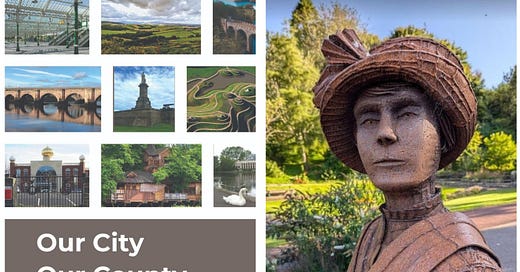Landmarks for a landmark anniversary
A society which has devoted a century to protecting and enhancing Northumberland and Newcastle is celebrating the milestone with a tribute to its very special qualities. Tony Henderson reports

A century ago Lt. Col John Douglas Mitchell took time out from running a tinned food factory to write a letter.
He was prompted by pride and a sense of identity felt by many who, before, since and today, have felt in belonging to the special place which is the North East, with its distinct character, accent, outlook and achievements.
Mitchell believed that the regional capital deserved a society devoted to the good of Newcastle, its inhabitants and a wider population who also considered it their city.
He was general manager of the Angus Watson Preserving Works on City Road, makers of Sailor brand tinned goods and soups, and Skippers sardines.
As such, he would have been well connected and wrote with his proposal to councillor David Adams, who would go on to be Sheriff of Newcastle, Lord Mayor, MP for Newcastle West and then Consett.
It worked, and at a public meeting in October 1924 at the Lit and Phil, it was resolved to set up the Newcastle upon Tyne Society ‘to promote a wider concern for the beauty, historical interest, amenity, healthfulness and development of the city’.
Mitchell became the society’s first secretary. Four sub committees were set up on town planning, ancient monuments, smoke abatement and arts and amenities.
Read more: ‘You shouldn’t have to put yourself into debt to tell a story about debt’
Five years later came the name change to the Northumberland and Newcastle Society.
The new society attracted distinguished members such as architect Robert Burns Dick, whose designs included the towers of the Tyne Bridge, the city centre magistrates courts and fire station, and the Spanish City Rotunda in Whitley Bay, plus a grandiose civic centre which never came to pass.
He led a campaign to create a green belt around the city and helped produce an inventory and map of pre-19th century buildings in the city centre to prevent further demolition and decay.
This year, the society has been celebrating its centenary, not least by marking the milestone with a new book titled Our City, Our County: An Anthology, which ranges over the buildings, landscapes and features of such a diverse area.

The society looked for contributors to come up with appreciations of favourite personal locations.
“We had a tremendous response,” says society chairman John Matthews. More than 60 contributors feature, with 90 locations covered.
Book editor Suzanne Stanley says: “The book could easily have been three or four times bigger.”
Some of the best known buildings do not appear, mainly because they are to be found in just about any other book portraying the area.
John says: “We wanted to make our book different and more personal, with contributors choosing places which are personal to them and often close to their hearts.”
Suzanne says that the volume, designed by Ray Huntly, isn’t a guide book – “there are plenty of those already.

“In asking people to submit buildings, landscapes and features to which they had a particular attachment, we hoped to direct readers on to back lanes and byways where treasures lie.
“The common theme is personal geography, our individual responses to the area in which we live, and the result is a fascinating range of contributions revealing the rich hinterland.
“What is striking is how many of the buildings and other features have been saved and restored by volunteers – a testament to how much people care about retaining the history, character and functionality of their localities.
“But there are modern buildings too that have caught people’s attention and affection, and are part of the legacy our generation will leave.”
With a membership of around 400, the N&N is now one of the country’s oldest active voluntary civic societies.
“We are as relevant in today’s ever-changing world as we were a hundred years ago,” says John.
“I believe we should all take an active interest in helping to shape the environment in which we live, be it built or natural, and be able to question and comment on government and local authority planning which influences or affects our daily lives.
“Our founders were forward thinking and their original aims we still endeavour to follow: ‘preservation, suggesting and influencing development, encouraging undertakings which add to the prestige of the city and county’.
One contributor is landowner and author Matt Ridley, whose family have lived on their Blagdon estate in Northumberland since 1700, where the society held its annual general meetings for years.
He has chosen the monumental landform Northumberlandia sculpture on his doorstep, created from 1.4m cubic metres of rock and soil from surface coal mining.
The view from the top of the head of the female form, 100 ft high, takes in views of Cheviot hills, the North Sea, and Newcastle – much of the area covered by the society.
Matt Ridley says: “Newcastle and Northumberland are very special places. I am surprised by how often people from elsewhere say they envy and admire our big skies, friendly people and generous landscapes.
“But fabulous as the beaches and hills of our region are, they would be less without alluring man-made embellishments - Bamburgh without a castle, the Whin Sill without the Roman Wall, the Tyne without its bridges, they would all be much the poorer.
“It was to celebrate and treasure this rich, long history of marrying culture and nature that the society was founded 100 years ago.”
It is a sentiment echoed by John Matthews, who says: “For a century the society has worked to protect and promote the heritage, culture and landscape of our region. What we all share is a deep and lasting passion for Newcastle , North Tyneside and Northumberland.”
Our City, Our County: An Anthology, edited by Suzanne Stanley, Northumberland and Newcastle Society, £20. You can order a copy here.






